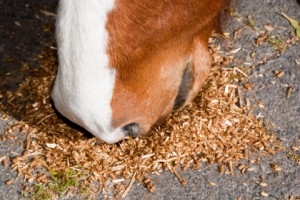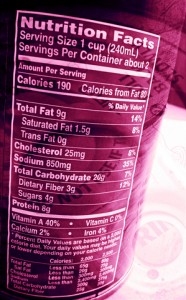|
By Patti Bartsch, M.A., Ph.D.
Ask many horse-people what they feed their horse and you'll likely get answers such as "a 12% pellet" or "a 14% sweet feed".
Ask the same people what they're feeding themselves and the answer is likely to be something along the lines of "whatever is fast and easy".
Equestrians are busy people.
Being so busy often leads to taking shortcuts and sometimes even tunnel vision when it comes to what we eat and what we feed our horses.

|
|
What you see isn't always what you get.
|
Case in point: take the issue of "a 12% pellet".
The 12% mentioned here is simply referring to the minimum amount of crude protein guaranteed to be in the feed.
By law, this "12% pellet" could actually contain 14, 16 or even 20% or more crude protein because 12% is just a guaranteed minimum.
You see, that number actually represents a measurement of nitrogen in the feed which is used to estimate the amount of protein.
Chicken feathers are high in nitrogen and some feed companies will intentionally add them to a feed formula to increase the crude protein measurement, but this is not a protein source that is available to the horses eating that feed.
The assumption by the person buying the feed is that there is 12% digestible (usable) protein in the feed; but that may not be the case.
The protein must be rich in a variety of amino acids and from a source that the horse is capable of utilizing.
Relax, most reputable feed companies don't put chicken feathers in horse feeds (more often in cattle feed) and it's also cheaper for them to keep the protein level as close to the guaranteed minimum as possible, so there's no need to panic at this point.
There are two things I want you to take away from the previous paragraph:
- There are a multitude of nutrients (vitamins, minerals, fats, amino acids, digestive aids, etc.) in a commercially prepared horse feed.
Why should you focus on just one (the protein)?
- What you see isn't always what you get.
This second item requires more discussion because the same can be said for what you feed yourself.
One of my nutrition professors had the best piece of advice about food packages.
He said, "Never, ever, believe anything written on the front of any food package… EVER! "
The regulations regarding what can be written on the front of a food package are very loose.
"Natural" implies that the food has nothing artificial in it, but in many cases, there are chemical preservatives or high-fructose corn syrup present.
Buying a food because it says "Natural" on the front is like buying a feed because it says "12% pellet".
There's a tiny bit of information there, but you need a lot more information in order to know if this is something you really want to buy and eat.
When reading a food label, always start with the ingredients!
When there are any grains listed on the label, you want the words "whole", "cracked" or "stone ground" to precede them, not "enriched", "bleached", or "unbleached".
If there's something listed there that your grandmother wouldn't have in her pantry, you probably want to pass.
Exclude foods that are made with:
- Enriched wheat flour
- High fructose corn syrup
- Natural and/or artificial flavors ("natural flavors" are sometimes only partially natural)
- Artificial sweeteners
- FD&C artificial colors
- Sodium benzoate
- Lecithin
- Potassium sorbate
- Disodium EDTA
- "Hydrogenated" oils
- Anything else that sounds like it came from a factory and not from the Earth

|
I won't go into a lot of detail on specific nutrients in this article, but I will suggest that you keep an eye on serving size and calories per serving.
Often, a can of soup or bottle of soda will actually contain TWO servings, but if you only look quickly at the number of calories, you might not realize that the item contains twice that amount.
Many people have no concept of how much a gram is.
A single sugar cube is approximately four grams.
A single cup of a popular strawberry-flavored milk has 28 grams of sugar per 8 ounces!
Isn't that what they serve in school cafeterias these days?
That's like putting 7 sugar cubes into a 1-cup measure and filling the rest with milk.
Now, imagine that a single can of your favorite cola has about 40 grams of sugar.
To visualize what that looks like, picture 10 sugar cubes in your hand.
Imagine the mass and weight of all that sugar — that's a lot of calories and no nutrition!
|
Reading and understanding food labels is one of the best things you can do to select and exclude packaged foods.
To save yourself a ton of time and effort, choose foods that don't require a label such as carrots, potatoes, squash, lettuce, tomatoes, avocados, walnuts, barley, brown rice, and apples.
In other words, choose more fruits and vegentables.
When you select a feed for your horse, read the entire guaranteed analysis section.
When you select a food for yourself, ignore the front of the package and read the ingredients and the nutrition facts.
Eliminate foods with unnatural ingredients that offer your body little in the way of nutrition and lots in the way of calories and chemicals.
Obviously, tunnel vision is not your friend when selecting the building blocks of your body. Being a label reader and a smart shopper takes some practice, but your health and nutrition are certainly worth the effort!
Patti Bartsch, M.A., Ph.D. is a Certified Holistic Life & Wellness Coach specializing in Equestrian Women around the world.
You can learn more about Patti and download a free chapter from her book "7 Steps to a Naturally Unbridled Life"" by visiting Naturally Unbridled.
Back to Article Index
|